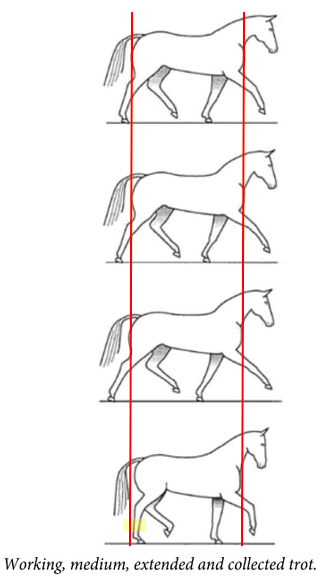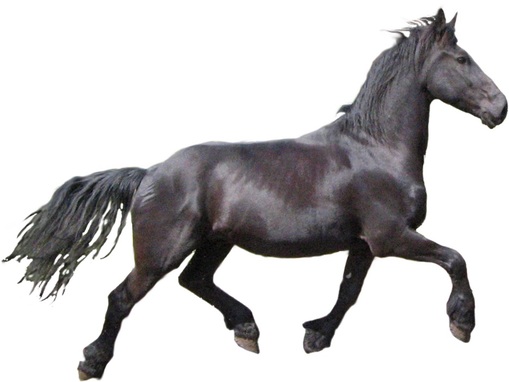You're getting ready to practice your dressage test. How hard could it be? A little trot, a little canter, a few circles. But then you notice terms like "working trot", "medium trot", "extended trot" and "collected trot". You're pretty sure you know the difference between extended and collected trot. But what's the difference between working and medium trot?
If you're confused, rest assured, you're not alone. Many dressage riders are unsure about what these terms mean.
If you're confused, rest assured, you're not alone. Many dressage riders are unsure about what these terms mean.

As they say, one picture is worth a thousand words, so take a look at the illustration to the left.
Working Trot: The horse should be properly balanced and remain on the bit. The horse should go forward with regular, elastic, and cadenced strides with good hock action. The trot is two-beat on alternate diagonal legs separated by a period of suspension.
Medium Trot: A pace between the working and the extended trots. While remaining on the bit, the horse lengthens and lowers the neck slightly as the strides are lengthened. The medium trot is "rounder" than the extended trot. The steps should be regular and the horse should remain balanced.
Extended Trot: The horse should cover as much ground as possible while maintaining the cadence. While remaining balanced and on the bit, the horse lengthens the frame and the stride as a result of great impulsion from the hindquarters. In the forward movement of the extension, the movement of the fore and hind legs should be similar (parallel).
Collected Trot: The collected trot is shorter than the working trot, but with increased lightness and mobility of the shoulders. The hocks should be well engaged, the croup lowered, and the horse should remain on the bit.
Video clips are even better than pictures, so here are some very short ones that demonstrate each of these trots.
Working Trot: The horse should be properly balanced and remain on the bit. The horse should go forward with regular, elastic, and cadenced strides with good hock action. The trot is two-beat on alternate diagonal legs separated by a period of suspension.
Medium Trot: A pace between the working and the extended trots. While remaining on the bit, the horse lengthens and lowers the neck slightly as the strides are lengthened. The medium trot is "rounder" than the extended trot. The steps should be regular and the horse should remain balanced.
Extended Trot: The horse should cover as much ground as possible while maintaining the cadence. While remaining balanced and on the bit, the horse lengthens the frame and the stride as a result of great impulsion from the hindquarters. In the forward movement of the extension, the movement of the fore and hind legs should be similar (parallel).
Collected Trot: The collected trot is shorter than the working trot, but with increased lightness and mobility of the shoulders. The hocks should be well engaged, the croup lowered, and the horse should remain on the bit.
Video clips are even better than pictures, so here are some very short ones that demonstrate each of these trots.
The difference between working and medium trot. The horse is in working trot at first, and changes to medium trot as they cross the diagonal. Notice how the gait lengthens in medium trot, but the tempo remains the same.
The difference between medium and extended trot. Notice how the legs stretch further and the body elongates, yet the tempo does not change.
The difference between extended and collected trot. Notice again how the tempo does not change, but the ground covered in each step differs dramatically. Also notice in collection how the horse's back is higher, his core muscles are engaged, and his hind legs are stepping well under his belly.
Tips to keep in mind:
- The horse should maintain a steady tempo, regardless of the type of trot.
- In medium trot, the horse reaches and rounds through his back more than in working trot.
- In medium and extend trot, the horse lengthens his stride so he covers more ground with each step. But the tempo remains the same. He does not get faster. When he collects, he covers less ground with each step.
- Collection has nothing to do with putting the horse's face on the vertical. The horse's back rises under you, his hind feet reach under his belly, his croup lowers, and his entire body becomes shorter from back to front.
You may also be interested in these articles:
How to Get a Horse to Lengthen His Gait
How to Engage A Horse's Hindquarters
How to Get a Horse to Stretch Down
How to Get a Horse on the Bit
Happy riding!
Copyright Denise Cummins, PhD, April 28, 2016
Opening Photo Credit: Trotting horse for SNIPS www.flickr.com/groups/snips/
How to Get a Horse to Lengthen His Gait
How to Engage A Horse's Hindquarters
How to Get a Horse to Stretch Down
How to Get a Horse on the Bit
Happy riding!
Copyright Denise Cummins, PhD, April 28, 2016
Opening Photo Credit: Trotting horse for SNIPS www.flickr.com/groups/snips/
We thought you might also like...
Dressage champions and FEI level judges agree that the best way to learn your dressage tests is to draw them. These high quality dry-erase arena boards have drawn-to-scale dressage arenas imprinted on them. Draw your test using a dry erase marker, wipe clean, and draw again until your test is letter perfect in your mind's eye! Then ride your test!















